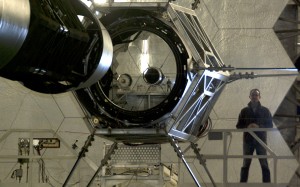Behind the Scenes: Maintaining Keck’s Massive Mirrors

UCR astronomer Brian Siana’s reflection is seen in the primary mirror (in center of photograph) inside the Keck I telescope (click to enlarge). Photo by Barbara Schaefer/Keck Observatory.
If you think washing the mirrors and windows in your home is a daunting task, imagine cleaning three dozen 880-pound mirrors measuring six feet in diameter. Called “segment exchange,” Keck technicians tackle this painstaking process—cleaning the twin 10-meter W.M. Keck Observatory telescope mirrors—every other month.
To add to the tedium, each of the two primary Keck mirrors are made up of 36 hexagonal segments coated with a thin, reflective aluminum layer. During the segment exchange, technicians physically remove each segment of for individual cleaning. To do this, the 10-meter honeycomb mirrors must be positioned at just the right angle. A large crane, which is mounted to the telescope’s domed ceiling, hoists each hexagonal piece from its support structure to the floor. At ground-level, the segment is maneuvered onto a special handling cart and wheeled from the dome. The segment is then placed in a 10-foot-deep pressurized vacuum chamber to strip and replace its aluminum mirror coating with a fresh layer.
At only 120 nanometers thick, the coating is roughly the depth of the groove in a DVD disk. But it serves a critical purpose in capturing and reflecting the incoming light astronomers use to learn about distant stars and planets. By replacing this coating regularly, the delicate metal layer maintains its reflectivity amid the eroding effects of air and weathering. Newly coated segments are estimated to be 17 percent more reflective, thereby capturing more photons that give astronomers important information about the cosmos.









